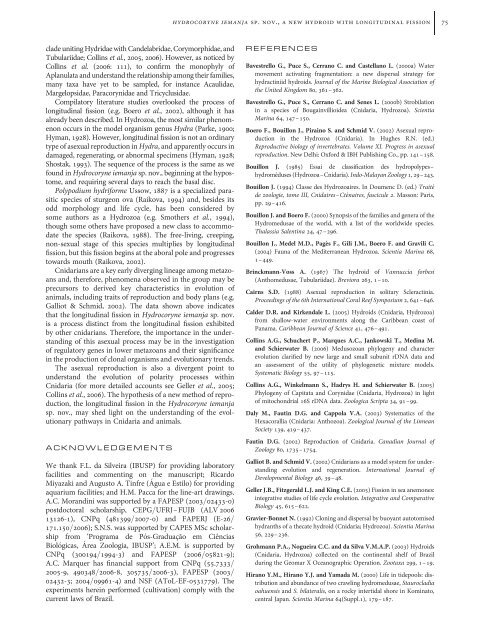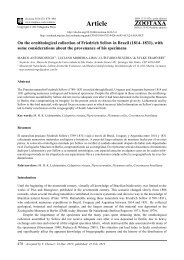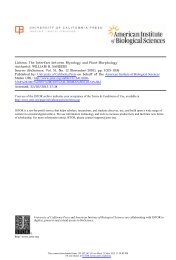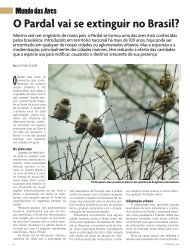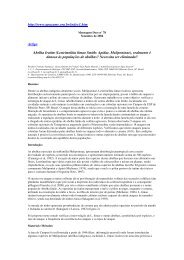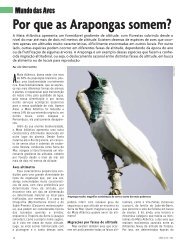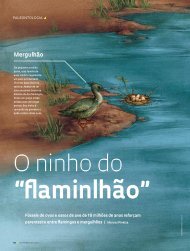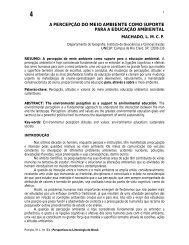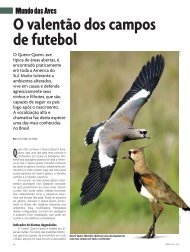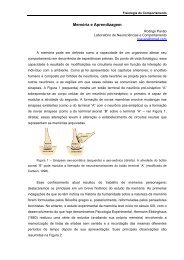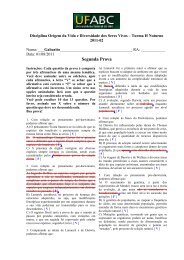Hydrocoryne iemanja (Cnidaria) - Instituto de Biociências - USP
Hydrocoryne iemanja (Cnidaria) - Instituto de Biociências - USP
Hydrocoryne iemanja (Cnidaria) - Instituto de Biociências - USP
You also want an ePaper? Increase the reach of your titles
YUMPU automatically turns print PDFs into web optimized ePapers that Google loves.
hydrocoryne <strong>iemanja</strong> sp. nov., a new hydroid with longitudinal fission 75<br />
cla<strong>de</strong> uniting Hydridae with Can<strong>de</strong>labridae, Corymorphidae, and<br />
Tubulariidae; Collins et al., 2005, 2006). However, as noticed by<br />
Collins et al. (2006: 111), to confirm the monophyly of<br />
Aplanulata and un<strong>de</strong>rstand the relationship among their families,<br />
many taxa have yet to be sampled, for instance Acaulidae,<br />
Margelopsidae, Paracorynidae and Tricyclusidae.<br />
Compilatory literature studies overlooked the process of<br />
longitudinal fission (e.g. Boero et al., 2002), although it has<br />
already been <strong>de</strong>scribed. In Hydrozoa, the most similar phenomenon<br />
occurs in the mo<strong>de</strong>l organism genus Hydra (Parke, 1900;<br />
Hyman, 1928). However, longitudinal fission is not an ordinary<br />
type of asexual reproduction in Hydra, and apparently occurs in<br />
damaged, regenerating, or abnormal specimens (Hyman, 1928;<br />
Shostak, 1993). The sequence of the process is the same as we<br />
found in <strong>Hydrocoryne</strong> <strong>iemanja</strong> sp. nov., beginning at the hypostome,<br />
and requiring several days to reach the basal disc.<br />
Polypodium hydriforme Ussow, 1887 is a specialized parasitic<br />
species of sturgeon ova (Raikova, 1994) and, besi<strong>de</strong>s its<br />
odd morphology and life cycle, has been consi<strong>de</strong>red by<br />
some authors as a Hydrozoa (e.g. Smothers et al., 1994),<br />
though some others have proposed a new class to accommodate<br />
the species (Raikova, 1988). The free-living, creeping,<br />
non-sexual stage of this species multiplies by longitudinal<br />
fission, but this fission begins at the aboral pole and progresses<br />
towards mouth (Raikova, 2002).<br />
<strong>Cnidaria</strong>ns are a key early diverging lineage among metazoans<br />
and, therefore, phenomena observed in the group may be<br />
precursors to <strong>de</strong>rived key characteristics in evolution of<br />
animals, including traits of reproduction and body plans (e.g.<br />
Galliot & Schmid, 2002). The data shown above indicates<br />
that the longitudinal fission in <strong>Hydrocoryne</strong> <strong>iemanja</strong> sp. nov.<br />
is a process distinct from the longitudinal fission exhibited<br />
by other cnidarians. Therefore, the importance in the un<strong>de</strong>rstanding<br />
of this asexual process may be in the investigation<br />
of regulatory genes in lower metazoans and their significance<br />
in the production of clonal organisms and evolutionary trends.<br />
The asexual reproduction is also a divergent point to<br />
un<strong>de</strong>rstand the evolution of polarity processes within<br />
<strong>Cnidaria</strong> (for more <strong>de</strong>tailed accounts see Geller et al., 2005;<br />
Collins et al., 2006). The hypothesis of a new method of reproduction,<br />
the longitudinal fission in the <strong>Hydrocoryne</strong> <strong>iemanja</strong><br />
sp. nov., may shed light on the un<strong>de</strong>rstanding of the evolutionary<br />
pathways in <strong>Cnidaria</strong> and animals.<br />
ACKNOWLEDGEMENTS<br />
We thank F.L. da Silveira (IB<strong>USP</strong>) for providing laboratory<br />
facilities and commenting on the manuscript; Ricardo<br />
Miyazaki and Augusto A. Tinfre (Água e Estilo) for providing<br />
aquarium facilities; and H.M. Pacca for the line-art drawings.<br />
A.C. Morandini was supported by a FAPESP (2003/02433-0)<br />
postdoctoral scholarship, CEPG/UFRJ–FUJB (ALV 0 2006<br />
13126-1), CNPq (481399/2007-0) and FAPERJ (E-26/<br />
171.150/2006); S.N.S. was supported by CAPES MSc scholarship<br />
from ‘Programa <strong>de</strong> Pós-Graduação em Ciências<br />
Biológicas, Área Zoologia, IB<strong>USP</strong>’; A.E.M. is supported by<br />
CNPq (300194/1994-3) and FAPESP (2006/05821-9);<br />
A.C. Marquer has financial support from CNPq (55.7333/<br />
2005-9, 490348/2006-8, 305735/2006-3), FAPESP (2003/<br />
02432-3; 2004/09961-4) and NSF (AToL-EF-0531779). The<br />
experiments herein performed (cultivation) comply with the<br />
current laws of Brazil.<br />
REFERENCES<br />
Bavestrello G., Puce S., Cerrano C. and Castellano L. (2000a) Water<br />
movement activating fragmentation: a new dispersal strategy for<br />
hydractiniid hydroids. Journal of the Marine Biological Association of<br />
the United Kingdom 80, 361–362.<br />
Bavestrello G., Puce S., Cerrano C. and Senes L. (2000b) Strobilation<br />
in a species of Bougainvillioi<strong>de</strong>a (<strong>Cnidaria</strong>, Hydrozoa). Scientia<br />
Marina 64, 147–150.<br />
Boero F., Bouillon J., Piraino S. and Schmid V. (2002) Asexual reproduction<br />
in the Hydrozoa (<strong>Cnidaria</strong>). In Hughes R.N. (ed.)<br />
Reproductive biology of invertebrates. Volume XI. Progress in asexual<br />
reproduction. New Delhi: Oxford & IBH Publishing Co., pp. 141–158.<br />
Bouillon J. (1985) Essai <strong>de</strong> classification <strong>de</strong>s hydropolypes–<br />
hydroméduses (Hydrozoa–<strong>Cnidaria</strong>). Indo-Malayan Zoology 1, 29–243.<br />
Bouillon J. (1994) Classe <strong>de</strong>s Hydrozoaires. In Doumenc D. (ed.) Traité<br />
<strong>de</strong> zoologie, tome III, Cnidaires–Cténaires, fascicule 2. Masson: Paris,<br />
pp. 29–416.<br />
Bouillon J. and Boero F. (2000) Synopsis of the families and genera of the<br />
Hydromedusae of the world, with a list of the worldwi<strong>de</strong> species.<br />
Thalassia Salentina 24, 47–296.<br />
Bouillon J., Me<strong>de</strong>l M.D., Pagès F., Gili J.M., Boero F. and Gravili C.<br />
(2004) Fauna of the Mediterranean Hydrozoa. Scientia Marina 68,<br />
1–449.<br />
Brinckmann-Voss A. (1967) The hydroid of Vannuccia forbesi<br />
(Anthomedusae, Tubulariidae). Breviora 263, 1–10.<br />
Cairns S.D. (1988) Asexual reproduction in solitary Scleractinia.<br />
Proceedings of the 6th International Coral Reef Symposium 2, 641–646.<br />
Cal<strong>de</strong>r D.R. and Kirkendale L. (2005) Hydroids (<strong>Cnidaria</strong>, Hydrozoa)<br />
from shallow-water environments along the Caribbean coast of<br />
Panama. Caribbean Journal of Science 41, 476–491.<br />
Collins A.G., Schuchert P., Marques A.C., Jankowski T., Medina M.<br />
and Schierwater B. (2006) Medusozoan phylogeny and character<br />
evolution clarified by new large and small subunit rDNA data and<br />
an assessment of the utility of phylogenetic mixture mo<strong>de</strong>ls.<br />
Systematic Biology 55, 97–115.<br />
Collins A.G., Winkelmann S., Hadrys H. and Schierwater B. (2005)<br />
Phylogeny of Capitata and Corynidae (<strong>Cnidaria</strong>, Hydrozoa) in light<br />
of mitochondrial 16S rDNA data. Zoologica Scripta 34, 91–99.<br />
Daly M., Fautin D.G. and Cappola V.A. (2003) Systematics of the<br />
Hexacorallia (<strong>Cnidaria</strong>: Anthozoa). Zoological Journal of the Linnean<br />
Society 139, 419–437.<br />
Fautin D.G. (2002) Reproduction of <strong>Cnidaria</strong>. Canadian Journal of<br />
Zoology 80, 1735–1754.<br />
Galliot B. and Schmid V. (2002) <strong>Cnidaria</strong>ns as a mo<strong>de</strong>l system for un<strong>de</strong>rstanding<br />
evolution and regeneration. International Journal of<br />
Developmental Biology 46, 39–48.<br />
Geller J.B., Fitzgerald L.J. and King C.E. (2005) Fission in sea anemones:<br />
integrative studies of life cycle evolution. Integrative and Comparative<br />
Biology 45, 615–622.<br />
Gravier-Bonnet N. (1992) Cloning and dispersal by buoyant autotomised<br />
hydranths of a thecate hydroid (<strong>Cnidaria</strong>; Hydrozoa). Scientia Marina<br />
56, 229–236.<br />
Grohmann P.A., Nogueira C.C. and da Silva V.M.A.P. (2003) Hydroids<br />
(<strong>Cnidaria</strong>, Hydrozoa) collected on the continental shelf of Brazil<br />
during the Geomar X Oceanographic Operation. Zootaxa 299, 1–19.<br />
Hirano Y.M., Hirano Y.J. and Yamada M. (2000) Life in ti<strong>de</strong>pools: distribution<br />
and abundance of two crawling hydromedusae, Staurocladia<br />
oahuensis and S. bilateralis, on a rocky intertidal shore in Kominato,<br />
central Japan. Scientia Marina 64(Suppl.1), 179–187.


